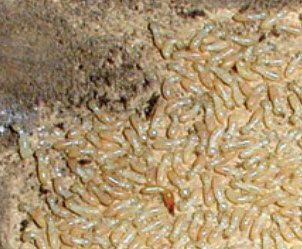- Desert subterranean termites can survive in drier conditions than Formosan or Eastern subterranean termites.
- Soldiers of Desert subterranean termites are characterized by their slender and straight mandibles, in contrast to the relatively thick, curved mandibles of Formosan or Eastern subterranean termites.
- Their small size and ability to forage under dry conditions allow them to occupy a niche not exploited by other subterranean termite species.
- Given the small size of Desert subterranean termite soldiers and workers, they are apt to penetrate smaller cracks in concrete and masonry that are too narrow for foragers of other subterranean termites to enter.
- Subtle differences in foraging behavior do exist. Foraging tubes are lighter in color, narrower, and more circular. Sometimes, Desert subterranean termites will openly build very narrow, free-hanging tubes from ceilings, shelves, and overhangs. Don't be surprised to see tubes as long as 6 to 12 inches in length! These tubes are often re-used by Desert subterranean termites.
Desert subterranean termites are commonly distributed throughout the lower deserts of northwestern Mexico, southern California, and Arizona.
Here are a few important facts you should understand about the behavior of Desert subterranean termites, compared to the more common subterranean termites such as Formosan or Eastern subterranean:
Interested in learning more about termites?

The assurance of a Trelona® ATBS Annual Bait Station licensed professional.
A termite control failure can mean frustration, disruption, stress, and damage to your home. There’s simply no substitute for the assurance and quality of service provided by licensed pest management professionals.

